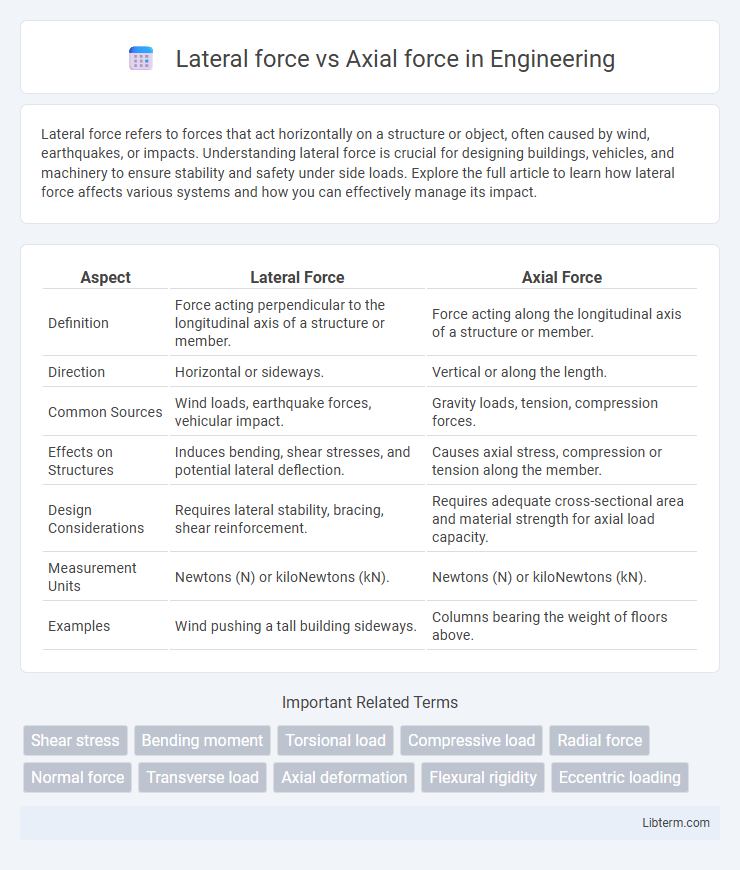Lateral force refers to forces that act horizontally on a structure or object, often caused by wind, earthquakes, or impacts. Understanding lateral force is crucial for designing buildings, vehicles, and machinery to ensure stability and safety under side loads. Explore the full article to learn how lateral force affects various systems and how you can effectively manage its impact.
Table of Comparison
| Aspect | Lateral Force | Axial Force |
|---|---|---|
| Definition | Force acting perpendicular to the longitudinal axis of a structure or member. | Force acting along the longitudinal axis of a structure or member. |
| Direction | Horizontal or sideways. | Vertical or along the length. |
| Common Sources | Wind loads, earthquake forces, vehicular impact. | Gravity loads, tension, compression forces. |
| Effects on Structures | Induces bending, shear stresses, and potential lateral deflection. | Causes axial stress, compression or tension along the member. |
| Design Considerations | Requires lateral stability, bracing, shear reinforcement. | Requires adequate cross-sectional area and material strength for axial load capacity. |
| Measurement Units | Newtons (N) or kiloNewtons (kN). | Newtons (N) or kiloNewtons (kN). |
| Examples | Wind pushing a tall building sideways. | Columns bearing the weight of floors above. |
Understanding Lateral and Axial Forces
Lateral forces act perpendicular to the axis of a structure, causing bending or shear stress, while axial forces act along the length of the structure, resulting in tension or compression. Understanding the differences between lateral and axial forces is crucial for designing structural elements that can withstand varying load conditions. Accurate analysis of these forces enhances safety and efficiency in engineering applications such as bridges, buildings, and mechanical components.
Definition and Key Differences
Lateral force refers to the force applied horizontally to a structure, causing bending or shear stress, while axial force acts along the length of a member, causing compression or tension. Lateral forces typically arise from wind, seismic activity, or side impacts, whereas axial forces result from loads like weight or tension along a column or beam. The key difference lies in their direction and effect on structural elements: lateral forces induce bending moments, and axial forces produce direct stress along the axis.
Sources of Lateral Force
Sources of lateral force primarily include wind pressure, seismic activity, and impact loads, which act perpendicular to a structure's longitudinal axis. Wind generates dynamic pressure on building facades, causing lateral displacement and stress in structural components. Earthquakes induce inertial forces due to ground acceleration, producing significant horizontal loads that require careful consideration in seismic design.
Sources of Axial Force
Axial force primarily originates from loads applied along the longitudinal axis of a structure, including tension, compression, and gravitational forces such as dead loads and live loads. Structural elements like columns and ties experience axial forces due to weight distribution, thermal expansion, and prestressing effects. Unlike lateral forces caused by wind or seismic activity, axial forces affect stability through direct compression or tension along the member's length.
Effects on Structural Integrity
Lateral force generates shear stress and bending moments that can cause structural displacement, deformation, or even collapse, particularly in tall buildings and bridges. Axial force induces compression or tension along the member's length, impacting load-bearing capacity and potentially leading to buckling or material failure. Understanding the interplay of these forces is crucial for designing resilient structures that maintain stability under complex load conditions.
Measurement Techniques for Each Force
Lateral force measurement typically employs strain gauges, piezoelectric sensors, and load cells designed to capture forces perpendicular to the primary axis, ensuring accurate detection of side loads in structures or machinery. Axial force measurement often utilizes load cells with axial alignment or hydraulic load cells that directly measure tensile or compressive forces along the axis of a component. Advanced techniques such as fiber optic sensors and ultrasonic methods provide enhanced sensitivity and real-time monitoring for both lateral and axial forces in complex engineering applications.
Common Applications in Engineering
Lateral force and axial force are critical in engineering design, with axial forces commonly encountered in columns, truss members, and tension cables where loads act along the longitudinal axis. Lateral forces, such as wind loads and seismic forces, predominantly impact beams, retaining walls, and bridges by acting perpendicular to the longitudinal axis. Understanding the distinction is essential for structural stability, as axial loads influence compressive or tensile stress while lateral loads induce bending and shear stresses in engineering components.
Importance in Structural Design
Lateral force and axial force are critical considerations in structural design, as lateral forces such as wind and seismic loads impact a building's stability and sway, while axial forces primarily influence the compressive or tensile stresses along structural elements. Accurately analyzing lateral forces ensures the prevention of excessive deformation and potential structural failure during dynamic events, whereas axial force assessment guarantees the safe transfer of loads through columns, beams, and foundations. Integrating both force types within design codes like ASCE 7 and Eurocode enhances the resilience and safety of structures under diverse loading conditions.
Failure Modes Associated with Each Force
Lateral force primarily induces bending and shear stresses, often causing structural components to fail through buckling, shear cracking, or delamination, especially in beams or columns under horizontal loads. Axial force generates compressive or tensile stresses along the member's length, leading to failure modes such as tensile fracture, compressive buckling, or crushing. Understanding these failure mechanisms is critical in designing safe structural elements capable of withstanding specific load conditions.
Strategies for Force Management and Control
Effective strategies for managing lateral and axial forces involve precise structural design and material selection to withstand directional stresses. Implementing advanced damping systems and bracing techniques helps control lateral forces caused by wind or seismic activity, while axial forces are managed through optimized load distribution and reinforced columns. Regular monitoring and adaptive control technologies enhance force management, ensuring stability and safety in engineering structures.
Lateral force Infographic

 libterm.com
libterm.com